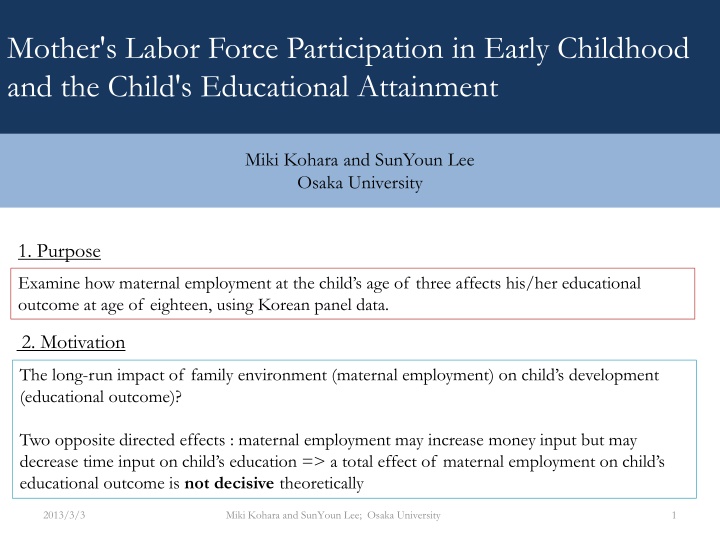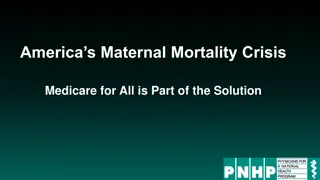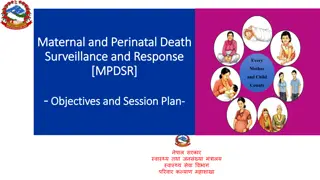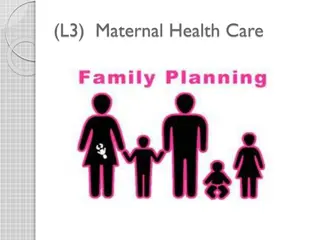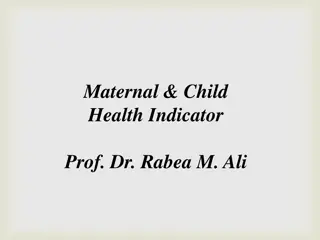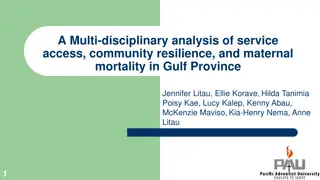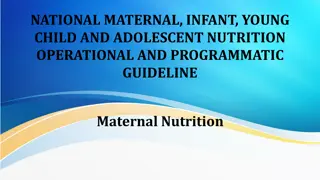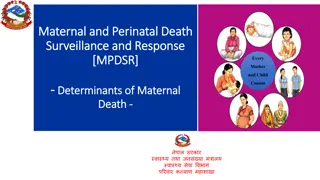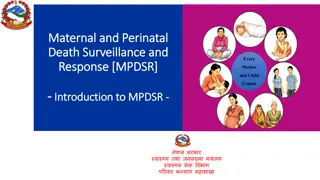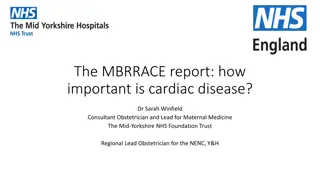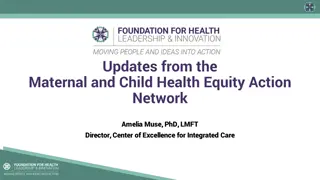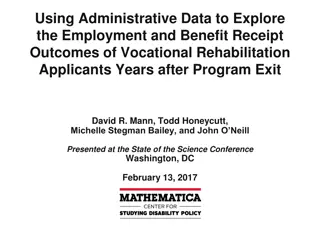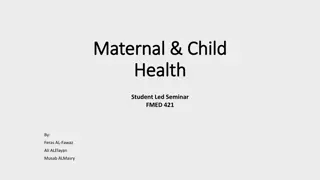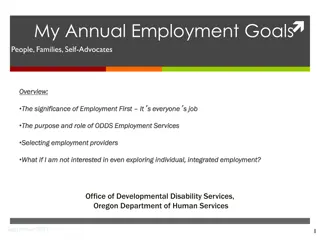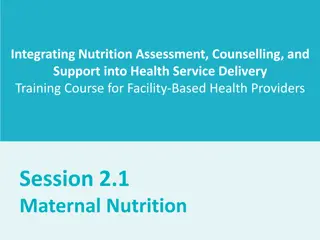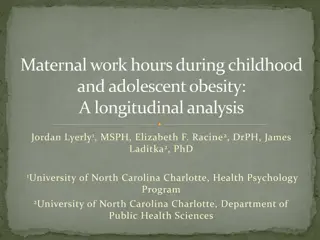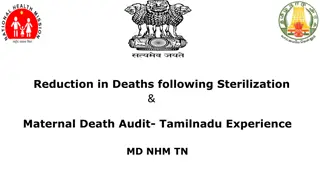Maternal Employment and Long-Term Educational Outcomes
This study explores the impact of maternal employment on a child's educational attainment from age three to eighteen, revealing differing effects based on the child's initial educational level. By analyzing Korean panel data, the researchers uncover the complex relationship between maternal labor force participation, family environment, and educational outcomes, highlighting the need to consider both money and time inputs. The study showcases the significance of maternal employment on a child's development and provides insights into the Korean context.
Download Presentation

Please find below an Image/Link to download the presentation.
The content on the website is provided AS IS for your information and personal use only. It may not be sold, licensed, or shared on other websites without obtaining consent from the author.If you encounter any issues during the download, it is possible that the publisher has removed the file from their server.
You are allowed to download the files provided on this website for personal or commercial use, subject to the condition that they are used lawfully. All files are the property of their respective owners.
The content on the website is provided AS IS for your information and personal use only. It may not be sold, licensed, or shared on other websites without obtaining consent from the author.
E N D
Presentation Transcript
Mother's Labor Force Participation in Early Childhood and the Child's Educational Attainment Miki Kohara and SunYoun Lee Osaka University 1. Purpose Examine how maternal employment at the child s age of three affects his/her educational outcome at age of eighteen, using Korean panel data. 2. Motivation The long-run impact of family environment (maternal employment) on child s development (educational outcome)? Two opposite directed effects : maternal employment may increase money input but may decrease time input on child s education => a total effect of maternal employment on child s educational outcome is not decisive theoretically 2013/3/3 Miki Kohara and SunYoun Lee; Osaka University 1
Introduction 3. Main Result Maternal employment at age three affects test scores at age eighteen, but the effect is opposite between high (minus effect) and low educational levels (plus effect) This result is obtained, after (1) controlling for mother s educational attainments, father s occupations, and economic conditions, (2) allowing for the existence of unobserved heterogeneity in a child s educational outcomes and the mother s employment, and (3) allowing for non-linearity (heterogeneity) in the effects. 4. Originalities and Contributions - Consider endogeneity of maternal employment and heterogeneity of its effect - Show a long-term effect of maternal employment on the child s development - Examine the Korean case 2013/3/3 Miki Kohara and SunYoun Lee; Osaka University 2
Introduction 2 5. Why Korea? - Important policy issue: there is a social concern about how parent s (mother s) behavior affects educational outcomes. > Education obsession > Extremely low married female labor supply - Good for the analysis: we can use test score data as educational outcomes CSAT College Scholastic Ability Test; once a year at the same time all over the country >Objective measure of educational outcomes >Showing a degree of educational attainments >Measuring outcomes at the end of high-school *Many students take this exam: 82% of the students in the last year of high school (04) 2013/3/3 Miki Kohara and SunYoun Lee; Osaka University 3
Labor Force Participation of Women (LPR) 2001 1981 4 2013/3/3 Miki Kohara and SunYoun Lee; Osaka University
LPR of married women LPR for the 25-29 age group were 7-27% points lower compared to those of other child bearing age groups of 20-24 and the 30-49 LPF for the age group 15-19 appears to have continuously declines since 1970. 2013/3/3 Miki Kohara and SunYoun Lee; Osaka University 5
Literature Review 1 6 Maternal employment deteriorates the child s educational outcomes? -Ambiguous results. Not always. The impact of maternal employment on child s development Baker, Gruber and Milligan (2008) Canada Ruhm (2008) USA for high economic condition group, but No effect for lower groups Bernal (2008) USA if a mother started working as a full time worker within a year after giving a birth No effect of temporary income change Dustman and Schonberg (2008) Germany Policy change of prolonged maternal leave raises child s educational outcomes Tanaka and Yamamoto (2009) Japan No effect of maternal employment at the child s age 0-3 * But maternal employment after that can lower the probability of going to (probably highly ranked) private or national junior high schools. 2013/3/3 Miki Kohara and SunYoun Lee; Osaka University 6
Literature Review 2 7 Literature on causation behind the effect (1 )Maternal employment more income & more investment on education child s educational attainments Ambiguous results (2) Maternal employment less time with children child s educational attainments Ambiguous results NOTE: Maternal employment full time worker / high-skilled labor = mother s higher education level child s educational attainments part-time worker / low-skilled labor = mother s lower education level child s educational attainments We need to control for mother s educational attainment. Maternal employment weak preference for child s care child s educational attainments strong preference for child s care child s educational attainments We need to remove a bias raised by unobserved heterogeneity. 2013/3/3 Miki Kohara and SunYoun Lee; Osaka University 7
Empirical Framework 1 Two difficulties in the estimation (2) Heterogeneous Effects Educational Outcomes at 18 years old -Linear estimation with endogenous variables can be biased. Estimation for different thresholds Mother s employment at age 3 Mother s unobserved ability Over/Under estimate Environmental effect or peer effect of female labor supply at that time, but not to affect child s educational outcome later at age of 18 Mother s preference for child s education Under/Over estimate (1) Problem of Endogeneity -Estimations with categorical data or quantile regression can be insufficient. Female Labor Force Participation Rates 2013/3/3 8
Empirical Framework 2 Non-linear simultaneous decisions = = + 1 x + + * T M 1 1 2 * M x 2 2 = * ( 1 = ) 0 T T * ( 1 ) 0 M M ( ) ( , 1 , 1 , 0 , 0 ) , | , ~ x x N 1 2 1 2 Ti is a dummy variable indicating 1 if a child s test score is in a higher group Mi is a dummy variable indicating 1 if his or her mother was working Method: Probit Model with Endogenous Treatment Data Korean Labor & Income Panel Study KLIPS) Note. Heterogeneous effect of maternal employment on child s test score: the effect could be different among the levels of test-scores. Conduct the estimation, changing the threshold! 2013/3/3 Miki Kohara and SunYoun Lee; Osaka University 9
Empirical Framework 3 Non-linear effect of maternal employment on child s test score = = + 1 x + + * T M 1 1 2 * M x 2 2 Idea! = * ( 1 = ) 0 T T Rank 12 * ( 1 ) 0 M M Rank 11 ( ) ( , 1 , 1 , 0 , 0 ) , | , ~ x x N Rank 10 1 2 1 2 Rank 9 Rank 8 =1 (if test score rank>=7) Rank 7 =0 (if test score rank<7) =1 (if test score==7) otherwise 0 (if test score 7) Rank 1 2013/3/3 Miki Kohara and SunYoun Lee; Osaka University 10
Data 1 Korean Labor and Income Panel Study KLIPS(1998-2008), conducted by the Korea Labor Institute, a government-sponsored research organization. Household Survey Householder or spouse nationally representative sample of 5,000 households Individual Survey Each person in the household aged 15 and over approx.12,000 persons) Additional Survey 2001 2008 yearly special modules for restricted sample, such as the youth, the old or the employed. approx.4500 persons Survey method Household Interview Data used for this study Additional Survey (2006): contains detailed information on education-related records of the youth aged 15 to 35 at the time of survey(4,389 persons) Maternal employment Individual and Household Surveys (1998-2006): individual characteristics Individual (2002): Test score for the College Scholastic Ability Test (CSAT) Individual (1998-2006): Parental and child s educational attainment, birth year and place to grow up, socio-economic status at age 14, father s occupation at age 14 Household (1998-2006): demographic information: family composition, marital status 2013/3/3 Miki Kohara and SunYoun Lee; Osaka University 11 11
Data 2 Important variables: (1) Educational Outcomes at age 18 Test score for the university entrance exam (CSAT) Historical changes in university entrance examination test 1. 1981-1993: Achievement Test started (Highest = 340) 2. 1994-1996: College Scholastic Ability Test 1 started (Highest = 200) 3. 1997- : CSAT 2 started (Highest = 400) 4. 2002- : Diversification of entrance exam. : University can use other types of exams. Our sample took either (1), (2) or (3). Test scores are answered as 12 ranks We need to control for the difficulties in each year. .4 .3 Density .2 .1 0 1 2 3 4 5 6 7 8 9 10 11 12 13 Testscore at age 18 Advantages of this indicator 1) Achievement test and college scholastic ability test were the most important single determinant for the university admissions in Korea. 2) Most of Korean high school students with the same academic attainment take the same test on the same day (advancement rate to university: 82%, test takers were 572,218 and third grade of high school students 582,216 in 2004) 3) Because the answers are formatted in score ranges with the interval of 10 to 40 scores, potential measurement errors may be small. 2013/3/3 Miki Kohara and SunYoun Lee; Osaka University 12 12
Data 3 KLIPS answer sheet 2013/3/3 Miki Kohara and SunYoun Lee; Osaka University 13 13
Data 4 Name of Variable Child's characteristics First child (=1) Number of siblings Mean S.D. Name of Variable Educational Outcomes Mean S.D. 0.401 1.885 0.491 1.093 Test score attained at the university entrance examination 7.856 2.420 Residential area at age 14 Family background Maternal Employment at child's age 3 (=1) 0.211 0.442 0.408 0.497 0.390 0.488 Sex 0.370 0.483 Female labor force participation rage at child's age 3 38.062 7.564 Kinds of university entrance exam 0.252 0.276 0.472 16.788 0.435 0.447 0.500 5.725 Mother's employment rate of the child's birth place 0.378 0.108 Degree of interaction with parents at age 14 Mother's educational attainment 3.028 1.100 Private education before school entry 0.276 0.447 Father's educational attainment 3.739 1.330 Living with parents at age 14 (=1) 0.025 0.157 0.049 0.230 0.568 0.154 0.217 0.421 0.496 0.361 Household economic status at age 14 Father s occupation = 1 if a father works in agricultural industry Miki Kohara and SunYoun Lee; Osaka University 14
Data 5 Notes: Average test scores are controlled for in several ways. - dependent variable: respondent s own score average test score whether this difference is positive or not / more than 30 or less than 30 / . - controlling for year dummies and/or average test score LPR of women when our sample was 2 to 5 years old % Source: National Statistical Office, Annual Report on the Economically Active Population Survey Economically Active Population: The employed and those are who are currently looking for a job LPR: (Economically Active Population/labor force aged 15 and over) 100 1 By age range Imputed from i) mother s age when the child was 3 years old and ii) LPR of women in Korea at the time at the child s age 3 => LPR by age range of mothers at child s age 3 2) By educational level Imputed from i) mother s educational attainment ii) LPR of women in Korea at the time at the child s age 3 3 => LPR by educational attainment of mothers at child s age 3 Test score ranks, 7 and 10 are focused. 2013/3/3 Miki Kohara and SunYoun Lee; Osaka University 15 15
Estimation Results 1 Dependent variable: test score attained at the university entrance examination Eq(1)(2) SLS Endogenous variable Maternal employment at child's age 3 2SLS Estimation First-stage regression Dependent variable: 12 test score ranks -0.3438 (2.666) Considering endogeneity but not heterogeneity in the effect (linear IV) Instrumental variable Female Labor Force Participation Rate (By age) 0.005 * (0.003) -0.053 ** (0.024) 0.027 (0.033) 0.058 (0.093) 0.095 (0.091) 0.097 (0.106) 0.392 *** (0.073) -0.122 (0.860) Father's educational attainment 0.3233* (0.186) 0.2160 (0.167) 1.2143** (0.573) 0.6414 (0.591) 0.9177 (0.656) 0.3422 (1.101) 15.7105*** (4.224) 483 5.14*** Mother's educational attainment Household economic status at age 14 (2) Household economic status at age 14 (3) Household economic status at age 14 (4) Father's occupation at age 14 Testscore_mean Observations F Test of all explanatory variables F Test of excluded instruments 4.39 *** 2.94 *
Estimation Results 2 Ordered Probit (Dependent Variable: Test score of university entrance exam) Variable Marginal Effect Dependent variable: Probability of being classified to each test score rank (12 ranks) Maternal employment Maternal employment at child's age 3 -0.0494 (0.086) 0.1104** (0.047) 0.1425** (0.058) 0.5252*** (0.198) 0.3052 (0.189) 0.3343 (0.211) 0.1011 (0.140) 6.8340*** (1.672) 636 98.20*** Test Score Ranks Father's educational attainment Rank 1 0.0001 (0.000) 0.001 (0.001) 0.002 (0.004) 0.003 (0.006) 0.005 (0.009) 0.005 (0.009) 0.003 (0.005) -0.001 (0.001) -0.003 (0.005) -0.005 (0.008) -0.005 (0.008) -0.007 (0.011) Mother's educational attainment Rank 2 Considering heterogeneity in the effect but not endogeneity (ordered probit) Household economic status at age 14 (2) Rank 3 Household economic status at age 14 (3) Rank 4 Household economic status at age 14 (4) Rank 5 Father's occupation at age 14 Rank 6 Testscore_mean Rank 7 Observations LR chi2(14) Rank 8 Rank 9 Rank 10 Rank 11 Rank 12
Estimation Results 3 Ordered Probit (Dependent Variable: Test score of university entrance exam) Dependent variable: Probability of being classified to each test score rank (3 ranks) Variable Marginal Effect Maternal employment Maternal employment at child's age 3 -0.0205 (0.096) 0.1269** (0.052) 0.1141* (0.065) 0.3883* (0.221) 0.2442 (0.210) 0.2733 (0.235) 0.0781 (0.156) 6.6600*** (1.866) 636 87.79*** Test Score Ranks Father's educational attainment Rank 1 0.0068 (0.032) -0.00013 (0.001) -0.0067 (0.031) Mother's educational attainment Rank 2 Considering heterogeneity in the effect but not endogeneity (ordered probit) Household economic status at age 14 (2) Rank 3 Household economic status at age 14 (3) Rank 1= test ranks 1-4 2= 7-9 3= 10-12 Household economic status at age 14 (4) Father's occupation at age 14 Testscore_mean Observations LR chi2(14) 18
Estimation Results 4 Dependent variable: 12 test score ranks Quantile Regression (Dependent Variable: Test score of university entrance exam) Variable Considering heterogeneous effects but not endogeneity (quantile regression) Maternal employment at child's age 3 -0.1565 (0.293) 0.4139*** (0.160) 0.0065 (0.196) 0.6729 (0.666) 0.1862 (0.634) 0.5193 (0.712) 0.0263 (0.470) -5.6133 (4.006) 636 0.0702 Father's educational attainment Mother's educational attainment Household economic status at age 14 (2) Household economic status at age 14 (3) Household economic status at age 14 (4) Father's occupation at age 14 These results suggest: We cannot find a robust unambiguous effect of maternal employment: either positive, negative, insignificant??? The effect of maternal employment may be heterogeneous: positive in lower groups, and negative in higher groups Observations Pseudo R2 19
Testscore_mean, included Higher than 10 Higher than 7 Estimation Results 5 Maternal employment at child's age 3 -1.5935*** (0.091) 1.5216*** (0.088) Female Labor Force Participation Rate (By age) 0.0151*** 0.0172*** (0.005) -0.1813** (0.072) 0.0991 (0.087) 0.2350 (0.272) 0.3635 (0.260) 0.3171 (0.285) -0.3107 (0.345) 0.0910 (0.126) 0.0381 (0.078) 0.1447 (0.133) -0.1885 (0.155) -0.0023 (0.163) -0.0205 (0.180) -0.0011 (0.178) Pr(T* 7) Lower threshold (0.005) Probit with endogenous decisions Considering endogeneity and heterogeneous effects Father's educational attainment 0.0070 (0.066) 0.1021 (0.080) 0.4126 (0.257) 0.3485 (0.245) 0.3825 (0.274) -0.3341 (0.298) 0.1986* (0.116) 0.0047 (0.069) 0.0695 (0.121) -0.2395* (0.145) -0.1008 (0.151) -0.0122 (0.165) -0.0140 (0.161) 0.8035*** 0.8262*** (0.166) 5.6941*** -0.2346 (2.143) -4.3390***-0.8206 (1.504) 483 0.2048*** -0.1701** (0.065) -0.0089 (0.083) 0.0844 (0.240) -0.0480 (0.233) 0.0350 (0.275) 0.2274 (0.306) 0.1275 (0.119) -0.0397 (0.065) -0.2727** 0.1976 (0.121) 0.0352 (0.152) -0.0572 (0.155) -0.0050 (0.168) -0.3358** -0.0121 (0.165) -0.5900***1.2082*** (0.213) 2.3708 (2.024) -2.0998 (1.438) 483 (0.069) 0.0994 (0.089) 0.1212 (0.269) 0.2586 (0.262) 0.1713 (0.303) -0.1904 (0.403) 0.0788 (0.131) -0.0173 (0.074) Pr(M=1) Pr(M=1) Mother's educational attainment Household economic status at age 14 (2) Household economic status at age 14 (3) Household economic status at age 14 (4) Living with parents at age 14 (=1) First child (=1) Number of siblings Dependent variable: Pr(T* 10) Higher threshold Male (=1) (0.133) -0.2911* (0.171) -0.0548 (0.175) 0.0140 (0.182) Residential Area at age 14 (6 metropolital cities) Residential Area at age 14 (9 provinces and Jeju) CSAT_1 Dependent variable: CSAT_2 (0.171) Father's occupation at age 14 (0.185) (0.239) -1.1752 (2.304) -0.1002 (1.655) 483 -11.6281 (19.522) Testscore (mean value by year) (2.392) Controlling for ave test scores Constants (1.677) 483 13.7974 (9.489) Observations rho:correlation between errors
Estimation Results 6 Probit with endogenous decisions Dependent variable: Pr(T*>= ) Higher threshold Lower threshold Higher than 10 Higher than 7 Maternal employment at child's age 3 -1.5935*** (0.091) 1.5216*** (0.088) Female Labor Force Participation Rate (By age) 0.0151*** (0.005) -0.1813** (0.072) 0.0991 (0.087) 0.2350 (0.272) 0.3635 (0.260) 0.3171 (0.285) 0.0172*** (0.005) Father's educational attainment 0.0070 (0.066) 0.1021 (0.080) 0.4126 (0.257) 0.3485 (0.245) 0.3825 (0.274) 0.8035*** 0.8262*** (0.166) 5.6941*** -0.2346 (2.143) 483 0.2048*** -0.1701** (0.065) -0.0089 (0.083) 0.0844 (0.240) -0.0480 (0.233) 0.0350 (0.275) -0.5900***1.2082*** (0.213) 2.3708 (2.024) 483 (0.069) 0.0994 (0.089) 0.1212 (0.269) 0.2586 (0.262) 0.1713 (0.303) Mother's educational attainment Household economic status at age 14 (2) Household economic status at age 14 (3) Household economic status at age 14 (4) Father's occupation at age 14 (0.185) (0.239) -1.1752 (2.304) 483 -11.6281 (19.522) Testscore (mean value by year) (2.392) 483 13.7974 (9.489) Observations rho:correlation between errors Controlling for ave test scores 21
Estimation Results 7 Probit with endogenous decisions Dependent variable: Pr(T*>= ) Higher threshold Lower threshold Higher than 10 Higher than 7 Maternal employment at child's age 3 -1.5967*** (0.092) 1.5475*** (0.092) Female Labor Force Participation Rate (By age) 0.0192*** (0.007) -0.1905*** (0.072) 0.1146 (0.087) 0.2908 (0.322) 0.4089 (0.315) 0.3608 (0.347) 0.0172** (0.007) Father's educational attainment 0.0323 (0.066) 0.1080 (0.081) 0.4367 (0.278) 0.3344 (0.267) 0.3597 (0.295) 0.7786*** 0.8733*** (0.173) Controlled 0.2189*** -0.1618** (0.067) -0.0252 (0.081) 0.0245 (0.257) -0.1037 (0.250) 0.0257 (0.288) -0.5786***1.2090*** (0.214) Controlled (0.073) 0.1031 (0.086) 0.1739 (0.278) 0.2883 (0.275) 0.2118 (0.317) Mother's educational attainment Household economic status at age 14 (2) Household economic status at age 14 (3) Household economic status at age 14 (4) Father's occupation at age 14 (0.201) (0.227) Testscore (year dummies) Controlling for test years 22
Estimation Results 8 Probit with endogenous decisions Dependent variable: Pr(T* AveT*>= ) Lower threshold Higher threshold Testscore Difference >=30 Testscore Difference >=0 Maternal employment at child's age 3 -1.0580** (0.523) 1.3462*** (0.077) Female Labor Force Participation Rate (By age) 0.0173** (0.007) -0.1663** (0.073) 0.0888 (0.087) 0.1793 (0.292) 0.2866 (0.283) 0.2863 (0.319) 1.0131*** (0.243) 533 0.7469 (0.566) 0.0101* (0.006) -0.1612** (0.067) 0.1015 (0.090) 0.2599 (0.281) 0.3229 (0.280) 0.3034 (0.317) 1.1700*** (0.250) Father's educational attainment 0.0361 (0.085) 0.0964 (0.085) 0.4418 (0.301) 0.3841 (0.290) 0.6204** (0.315) 0.3116 (0.328) 483 0.1615*** (0.061) -0.0103 (0.079) -0.0390 (0.249) -0.2075 (0.245) -0.0697 (0.277) -0.7989*** (0.209) 483 Mother's educational attainment Household economic status at age 14 (2) Household economic status at age 14 (3) Household economic status at age 14 (4) Father's occupation at age 14 = 1 if a father works in agricultural industry Observations rho:correlation between errors -4.5578 (5.395) Marginal Effect Maternal employment at child's age 3 -.4657106 .5297742 23
Estimation Results 9 Summary of the results Maternal employment at age 3 lowers the probability that a child is ranked in higher than or equal to 10 (whether or not a child can go to so-called good universities) Maternal employment at age 3 raises the probability that a child is ranked in higher than or equal to 7 (whether or not a child can go to universities or colleges) Unobservables are controlled for by a simultaneous estimation mechanism. Parent s education, occupation, and economic conditions are also controlled for. We attempted the other splits based on parent s educational levels, occupation, and economic conditions, but we could not find any difference between the groups. Maternal employment deteriorates the child s educational outcomes for students in high ranks. But maternal employment raises the child s educational outcomes for students in low ranks. 2013/3/3 Miki Kohara and SunYoun Lee; Osaka University 24
Estimation Results 10 Why opposite effects? Maternal employment may decrease an interaction time with children, which discourages test score for children in high test-score groups. This deteriorating effect may be offset by the positive effect of money inputs increased by maternal employment in low test-score groups. Maternal employment Child s education High-ranked groups: time (-) >>> money (+) Low-ranked groups: time (-) <<< money (+) 25
Conclusion Results and Implications Maternal employment at age three affects test scores at age eighteen, but the effect is opposite between high (minus effect) and low educational levels (plus effect) Explanation other than parent s education, occupation and economic conditions should be given. One possibility is that maternal employment may decrease an interaction time with children, which discourages test score for children in high test-score groups. This deteriorating effect may be offset by the positive effect of money inputs increased by maternal employment in low test-score groups. 1. Not only discouraging effect but also encouraging effect of maternal employment on child s educational attainments is found at least for those who were born between 80s & 90s in Korea. 2. We need to consider both endogeneity of maternal employment and heterogeneity in its effect when discussing maternal effect on the child s educational outcomes. 2013/3/3 Miki Kohara and SunYoun Lee; Osaka University 26
Testscore Difference >=30 Testscore Difference >=0 Maternal employment at child's age 3 -1.5030*** (0.088) 1.3649*** (0.078) Female Labor Force Participation Rate (By age) 0.0158*** (0.005) -0.1514** (0.073) 0.1054 (0.085) 0.2074 (0.309) 0.3789 (0.307) 0.3135 (0.333) -0.2777** (0.135) 533 12.1083 (12.100) 0.0092 (0.006) -0.1521** (0.069) 0.1221 (0.093) 0.2859 (0.286) 0.3611 (0.286) 0.3466 (0.324) -0.1956 (0.129) Father's educational attainment -0.0453 (0.062) 0.0877 (0.078) 0.3768 (0.258) 0.3350 (0.249) 0.5356* (0.278) 0.1891 (0.122) 482 0.1372** (0.062) -0.0259 (0.080) -0.0837 (0.257) -0.3003 (0.255) -0.1695 (0.285) 0.3876*** (0.115) 482 Mother's educational attainment Household economic status at age 14 (2) c.f. Household economic status at age 14 (3) Household economic status at age 14 (4) Degree of interaction with parents at age 14 Observations rho:correlation between errors -11.0742 (7.871) Marginal Effect Maternal employment at child's age 3 -.7800035 .5375795
